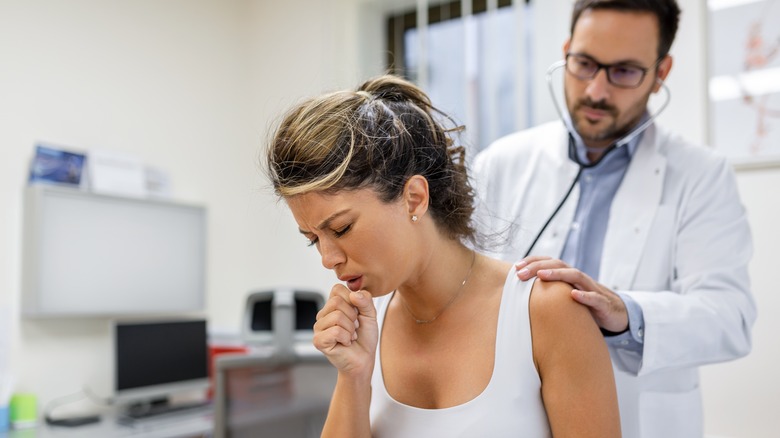What's The Difference Between Walking Pneumonia And 'Normal' Pneumonia?
Pneumonia is a lung infection that can be caused by various microorganisms, including bacteria, viruses, and fungi (via the Mayo Clinic). According to the Centers for Disease Control and Prevention (CDC), there were 1.5 million emergency room visits for pneumonia in 2020.
According to the Mayo Clinic, the general symptoms of pneumonia can include fever, cough, shortness of breath, chest pain, and fatigue. However, different types of pneumonia exist, including walking pneumonia, per the Cleveland Clinic. Various factors characterize the different types of pneumonia, including the cause and severity of the infection, which can range from mild to severe, says the Mayo Clinic.
Pneumonia can be life-threatening, especially for older adults, young children, and individuals with weakened immune systems and pre-existing conditions. If you or someone you know belongs to one of those categories and develops symptoms of pneumonia, it's important to see a healthcare provider. This is also true for people who don't belong to a high-risk group but develop chest pain, difficulty breathing, a persistent cough, or a persistent fever of at least 102 degrees Fahrenheit. With proper treatment and care, most people with pneumonia can recover.
What makes walking pneumonia different from 'normal' pneumonia?
Walking pneumonia and "normal" pneumonia are both forms of pneumonia, but there are some differences. According to the Mayo Clinic, normal pneumonia can be life-threatening, particularly in older adults, young children, and people with weakened immune systems. Normal pneumonia is often caused by bacteria, such as Streptococcus pneumoniae, though it may also be caused by viruses and fungi.
On the other hand, walking pneumonia is a milder form of pneumonia. It is often caused by a type of bacteria called Mycoplasma pneumoniae (via WebMD). According to WebMD, it is also known as "atypical pneumonia" because it does not cause the same severe symptoms as "normal" pneumonia.
Instead, people with walking pneumonia may experience symptoms such as a cough, mild fever, fatigue, sneezing, and chills, per the Cleveland Clinic. According to the clinic, they are often able to carry on with their daily activities, hence the name "walking pneumonia."
In summary, the main difference between walking pneumonia and normal pneumonia is the severity of the symptoms.
How is pneumonia treated?
Walking pneumonia, also known as atypical pneumonia, is often treated with antibiotics, per the Cleveland Clinic. Among the most commonly prescribed antibiotics for walking pneumonia are macrolide drugs such as azithromycin and clarithromycin, per the clinic.
Over-the-counter pain relievers such as NSAIDs can help to reduce fever and relieve body aches and other discomforts. Drinking warm fluids and getting rest can also help to speed up the recovery process, says the clinic.
If the cause is bacterial, then normal pneumonia is also treated with antibiotics. People with the condition are also advised to have lots of rest and drink enough fluids. However, hospitalization may be necessary for people with severe or complicated pneumonia.
If you have serious pneumonia, you might require oxygen therapy, intravenous antibiotics, and other care, according to the American Lung Association. Drainage of fluids between your lungs and chest wall might also be required if the build-up is too much, explains the Cleveland Clinic.



